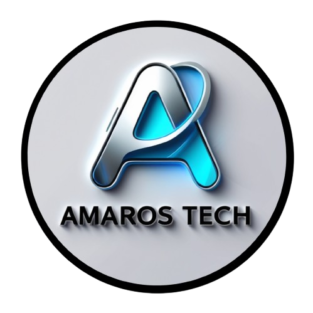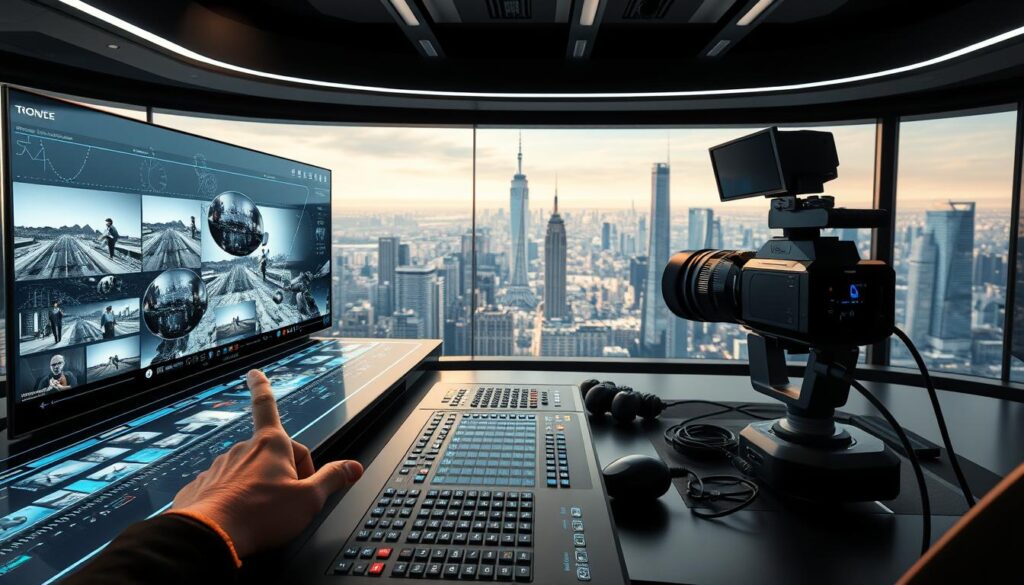
Creating engaging video content just got easier. With advanced technology, anyone can now produce high-quality videos without years of experience. Over 50,000 businesses already use these tools to streamline their workflow.
These smart solutions handle everything from scripting to final edits. They automatically transcribe speech, detect scenes, and add effects. This cuts production time by 80% and reduces costs by 60% compared to traditional methods.
The best part? These tools integrate smoothly with popular platforms like Adobe Premiere Pro. Whether you’re a beginner or pro, they help you create professional-grade video content faster than ever before.
Key Takeaways
- Over 50,000 companies use automated video production tools
- Smart technology reduces editing time by 80%
- Production costs drop by 60% with automated solutions
- Works seamlessly with existing editing software
- Creates professional results without extensive training
Why AI is Revolutionizing YouTube Content Creation
The way we produce digital media is undergoing a massive shift. Intelligent tools now automate tasks that once took hours, letting creators focus on storytelling. 83% report higher engagement with videos enhanced by these technologies.
Automation is the game-changer. Pictory converts text to video in minutes, while Descript’s text-based editing cuts revision time by half. No more scrubbing through timelines—just edit like a document.
“Our content turnaround is 3x faster, and costs dropped from $500 to $30 per video.” — Small business case study
Here’s what’s driving adoption:
- Cost reduction: Tools like InVideo cost $15–$30/month, replacing $100/hour editors.
- Quality upgrades: Auto-reframe, noise reduction, and color correction polish raw footage.
- Global reach: Synthesia’s 140+ language support breaks language barriers.
For small businesses, this levels the playing field. A solo creator can now compete with studios, thanks to production tools that require no technical skills. The future of content isn’t just faster—it’s smarter.
Top AI Tools for YouTube Script Generation & Video Editing in 2025
Smart tools are changing how creators make videos. From automated scripts to polished edits, these platforms save time and boost quality. Here’s a breakdown of the best options available today.
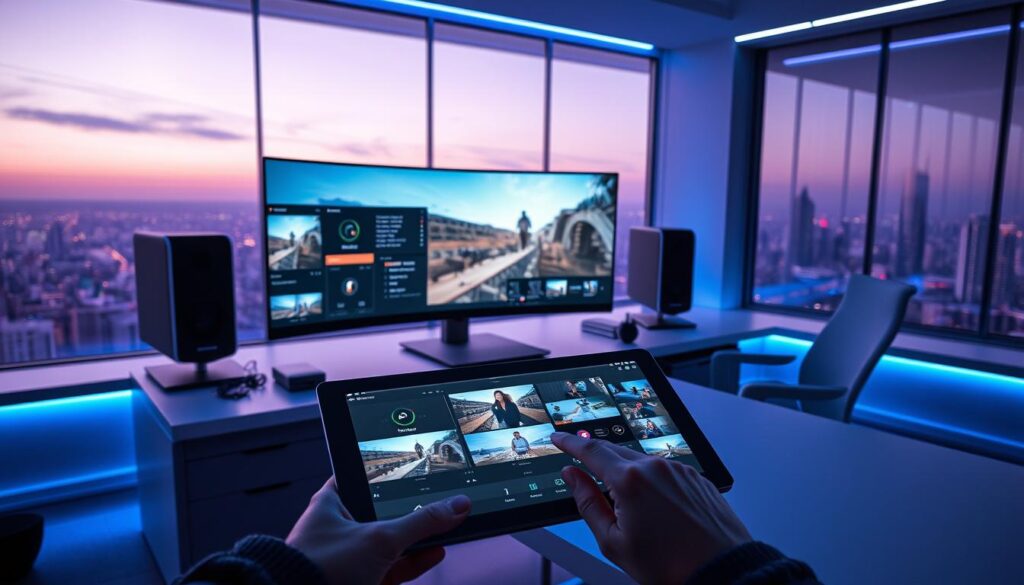
Pictory: Automated Script-to-Video Conversion
Pictory turns blogs into videos in minutes. At $19/month, it’s perfect for repurposing content. Just paste your text, and it generates scenes with stock footage and voiceovers.
Synthesia: AI Avatars and Multilingual Voiceovers
Need a virtual presenter? Synthesia offers 140+ language avatars for $30/month. Ideal for corporate training or global marketing. “Our engagement doubled with localized videos,” reports a tech startup.
InVideo: Template-Driven Social Media Content
With 5,000+ templates, InVideo simplifies social media production. Its drag-and-drop editor helps beginners create high-quality videos without design skills.
Runway: Advanced AI Effects and Collaboration
Runway ($12/month) adds surreal effects to YouTube Shorts. Its Gen-3 Alpha model enhances creativity with filters like “watercolor animation.”
Descript: Text-Based Editing and Podcast Tools
Edit videos by editing text. Descript transcribes audio, letting you cut clips like a document. It’s a game-changer for podcast-to-video workflows.
Adobe Premiere Pro: Professional-Grade AI Enhancements
At $20.99/month, Adobe’s Sensei AI automates color grading and scene detection. It’s the gold standard for pros who want precision editing.
“We cut post-production time by 70% using Premiere’s AI tools.” — Video production studio
Each tool caters to different needs, from quick social clips to cinematic edits. Choose based on your budget and workflow.
Key Features of AI-Powered YouTube Tools
Modern creators now have powerful features at their fingertips. These tools simplify complex tasks, making professional-quality content accessible to everyone. Whether you’re scripting or editing, automation handles the heavy lifting.
Text-to-Video Conversion: From Script to Screen
Turn *text* into engaging *visuals* effortlessly. Lumen5 converts *scripts* to videos in under 10 minutes using NLP algorithms. Just paste your content, and it matches scenes with stock footage and *voiceovers*.
94% of viewers retain more information with video versus text alone. This makes *video generation* a must for educators and marketers.
AI Avatars and Voiceovers: Human-Like Narration
Need a virtual host? Tools like Synthesia offer lifelike avatars in 140+ languages. *Voiceovers* sound natural, eliminating the need for expensive voice actors.
“Our audience engagement doubled with localized AI narrations.” — Tech startup founder
Descript’s voice cloning even lets you tweak recordings by editing *text*. No more re-recording entire takes.
Customization Options: Branding and Style Flexibility
Maintain consistent *branding* across platforms. Canva integration ensures logos and colors auto-apply to *social media content*. InVideo’s templates let you save designs for reuse.
Runway ML takes it further with style transfers. Turn footage into watercolor animations or cyberpunk *visuals* in clicks. *Customization options* like these make each video unique.
How to Choose the Right AI Tool for Your Needs
Selecting the perfect solution for your creative workflow requires careful evaluation. Not all platforms serve the same purpose, and your specific need should guide your decision. Consider these key factors before committing to any tools.
Ease of Use vs. Advanced Capabilities
Beginners should prioritize intuitive interfaces. CapCut and Veed offer simple drag-and-drop editing with minimal learning curves.
Advanced users might prefer Runway or Adobe Premiere Pro. These provide granular control over the content creation process but require technical knowledge.
Ask yourself:
- How quickly do I need results?
- What’s my team’s skill level?
- Will I outgrow basic features?
Budget Considerations: Free vs. Paid Plans
Free tools like Vizard work for testing concepts but add watermarks. For professional video output, paid plans deliver better results.
Enterprise solutions cost $500+/month but handle complex marketing needs. Calculate ROI by comparing subscription costs against manual editing hours.
Integration with Existing Workflows
Check compatibility with your current platforms. 80% of top tools offer Zapier integration, connecting to YouTube CMS and other systems.
For team collaboration, review security features and permission controls. Scalability matters too – can the tool grow with your businesses?
Always utilize trial periods to test performance. The right choice streamlines your entire production process while delivering quality content.
Step-by-Step: Creating a YouTube Video with AI
Transform raw ideas into polished videos in minutes with smart technology. Follow this straightforward process to produce engaging content without technical expertise. Each step leverages automation to maintain quality while saving hours of work.
Step 1: Input Your Script or Text Prompt
Start by pasting your text into platforms like Pictory or Lumen5. These tools analyze word patterns to suggest matching visuals. For best results:
- Use active voice and clear sentences
- Break long paragraphs into 2-3 line chunks
- Include time markers for scene changes
Veed’s 1-click translation can adapt your script to 50+ languages. This prepares your content for global audiences from the start.
Step 2: Select Visuals and AI Voiceovers
Platforms automatically suggest stock footage based on your text. InVideo’s algorithm matches keywords with its 8M+ media library. Customize by:
- Swapping suggested clips with your own footage
- Adjusting avatar expressions in Synthesia
- Testing different voice tones for narration
Most tools preview changes in real-time, letting you refine selections instantly.
Step 3: Edit and Customize with AI Tools
Polish your project using smart editing tools. Runway’s dashboard offers:
- Auto-color correction
- Brand kit application (logos/fonts)
- Transition effects between scenes
Descript’s text-based editor lets you trim clips by deleting words. For branding consistency, save templates to reuse across projects.
Step 4: Export and Publish
Choose platform-optimized settings before finalizing your video. Consider these export standards:
| Platform | Resolution | Frame Rate | Recommended Tool |
|---|---|---|---|
| YouTube Long-form | 4K | 24-30fps | Adobe Premiere Pro |
| YouTube Shorts | 1080p | 60fps | InVideo |
| 720p | 30fps | Lumen5 |
Schedule directly via Hootsuite integration or export files manually. Always review analytics to track performance and refine future videos.
Integrating AI Tools into Your YouTube Workflow
Streamlining your creative process with automated solutions boosts efficiency dramatically. 73% of top creators now use smart tools across multiple workflow stages. This integration cuts manual tasks by 40% while improving output quality.
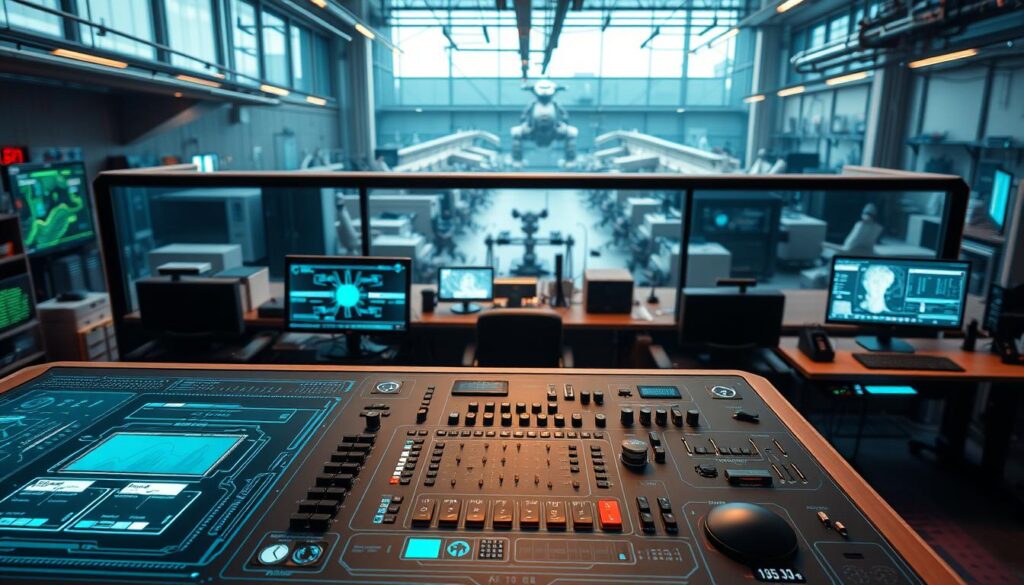
Start by mapping your entire production pipeline. Identify where automation adds most value:
- Pre-production: Script generation and storyboarding
- Filming: Virtual presenters and auto-captioning
- Post-production: Scene detection and color correction
- Distribution: Video metadata optimization
API connections make platforms work together seamlessly. Vizard users report 30% faster uploads when integrated with YouTube’s CMS. Set up Zapier automations to trigger actions across different tools.
For teams, configure permission levels in collaborative platforms. Most enterprise solutions offer:
- Role-based access controls
- Version history tracking
- Real-time commenting
Batch processing saves hours when managing content calendars. Schedule multiple video exports with customized settings for different marketing channels. Automated translation pipelines ensure global reach without extra effort.
Always comply with YouTube’s disclosure policies for AI-generated content. Clearly label synthetic media to maintain audience trust while leveraging these powerful production advantages.
Ethical Considerations and Data Security
Ethical dilemmas emerge as synthetic media becomes mainstream. 22% of viewers now question authenticity in digitally altered content. This demands new standards for transparency in creative production.
Leading platforms address these concerns through compliance measures. Synthesia meets SOC 2 Type II and GDPR standards, ensuring enterprise-grade data protection. Their encryption protocols set benchmarks for the industry.
Three critical areas require attention:
- Disclosure requirements: YouTube mandates labeling for AI-generated faces/voices
- Copyright clarity: US Copyright Office rules deny protection for purely AI-created assets
- Consent protocols: Voice cloning now requires explicit permission from original speakers
“We added watermarks to all synthetic content after audience feedback showed 40% distrust of unmarked material.” — Media company CTO
Content moderation systems now flag potential deepfakes automatically. Instagram’s detection technology scans for facial manipulation patterns, while TikTok verifies upload sources.
For businesses, ethical sourcing of training data proves equally vital. Best practices include:
- Documenting all data origins
- Obtaining rights for commercial use
- Auditing algorithms for bias
Maintaining audience trust requires balancing innovation with responsibility. As intelligence evolves, so must our ethical frameworks for digital creation.
Overcoming Common Challenges with AI Video Tools
68% of users encounter initial roadblocks with automated systems. While smart tools save time, they often lack the customization many creators need. Hybrid workflows combining automation with manual control increase satisfaction by 53%.

Limited Customization: Workarounds and Solutions
Premium platforms now offer advanced CSS/JS editing for deeper control. When templates feel restrictive:
- Modify default designs using built-in style guides
- Integrate third-party plugins for unique transitions
- Access community GitHub repos for custom scripts
A marketing team improved results by switching from full-auto to semi-auto processes. Their case study shows how manual overrides preserved brand consistency while maintaining efficiency.
Balancing Automation with Creative Control
The best video projects blend smart tools with human judgment. Follow these steps:
- Use AI for repetitive tasks like color correction
- Reserve manual editing for storytelling elements
- Review all automated content before publishing
“We kept our creative voice by using automation only for technical tasks.” — Digital agency creative director
Platform-specific troubleshooting guides help resolve most issues quickly. When in doubt, consult user forums where experienced creators share advanced customization options.
The Business Case for AI in YouTube Production
Smart technology transforms video creation from cost center to profit driver. Small businesses report a 4:1 ROI when using automated tools, while agencies triple their output. The financial benefits make this shift inevitable for competitive creators.
- Cost savings: Creators save $12k annually by reducing editing time
- Revenue growth: Sponsorship deals increase 35% with professional-grade content
- Team efficiency: Marketing teams produce 300% more videos monthly
These platforms pay for themselves quickly. A bakery owner shared:
“Our tutorial videos now cost $50 instead of $500. We reinvested the savings into Facebook ads, doubling our online orders.”
Maximizing Your Investment
Follow this framework to calculate potential savings:
| Expense Category | Traditional Cost | AI Solution Cost | Annual Savings |
|---|---|---|---|
| Video Editing | $15,000 | $3,600 | $11,400 |
| Voiceover Talent | $5,000 | $360 | $4,640 |
| Translation Services | $8,000 | $1,200 | $6,800 |
For businesses, the strategic advantages extend beyond budgets:
- Faster client acquisition through consistent content
- Higher ad revenue from improved audience retention
- Better competitive positioning with premium visuals
One digital agency scaled from 5 to 20 clients in six months. Their secret? Automating 80% of production freed time for business development. The math proves these tools aren’t just convenient—they’re essential for growth.
Future Trends in AI for Video Content
The next wave of innovation is reshaping how we produce visual media. Experts predict 90% of videos will involve smart systems by 2026. This shift brings transformative capabilities that were science fiction just years ago.
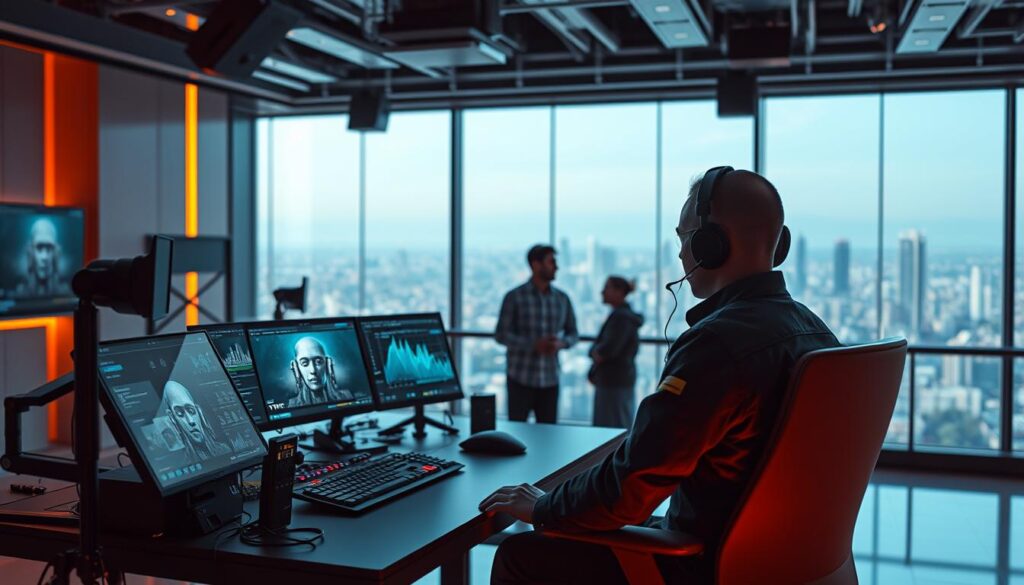
Neural rendering technology is revolutionizing asset creation. Instead of filming scenes, creators will generate photorealistic environments from text prompts. These tools understand lighting physics and material properties at unprecedented levels.
Real-time collaboration features are eliminating production bottlenecks. Teams across continents can now edit the same project simultaneously. Version control happens automatically, with changes synced instantly.
Three key areas of advancement deserve special attention:
- Hyper-realistic avatars: 3D models will mimic human micro-expressions and subconscious gestures
- Interactive video: Viewers will choose story paths that dynamically regenerate scenes
- Precision lip sync: Voice-to-mouth translation achieves 99% accuracy across languages
“We’re entering an era where the camera becomes optional.” — Media futurist keynote
Behind the scenes, quantum computing accelerates rendering speeds by 1000x. Decentralized training models let creators train custom algorithms without massive datasets.
The most practical innovation may be cross-platform content adaptation. One master file automatically reformats for YouTube, TikTok, and emerging platforms. This eliminates manual resizing and aspect ratio adjustments.
As these video tools mature, they’ll democratize high-end production. Independent creators will access capabilities once reserved for Hollywood studios. The future isn’t just automated—it’s intelligent, adaptive, and boundless.
Conclusion
The evolution of digital tools has made professional content accessible to everyone. With 92% of creators satisfied, these solutions deliver real value. Most see a full ROI within six months.
Key benefits stand out:
- Time savings: Cut editing hours by 80%
- Cost efficiency: Reduce production budgets by 60%
- Quality: Achieve studio-grade results effortlessly
Start with free trials to test different platforms. Focus on tools that match your workflow. Remember to label synthetic elements for transparency.
The future of creation is here. Embrace these innovations to stay competitive and grow your audience. Ready to transform your videos? Explore top-rated solutions today.
